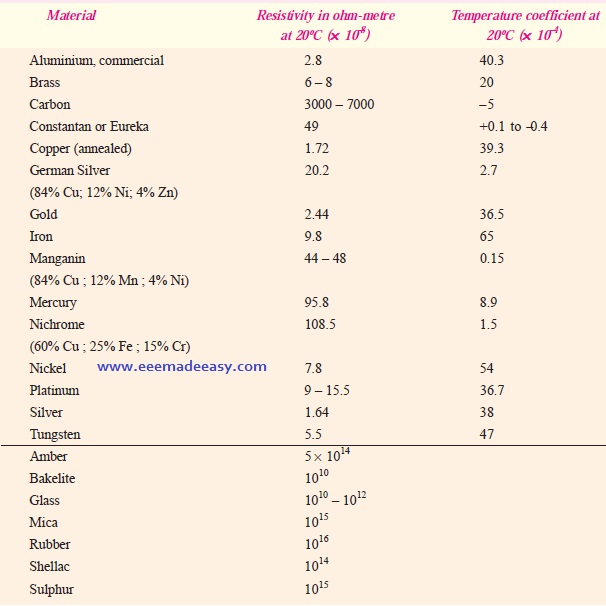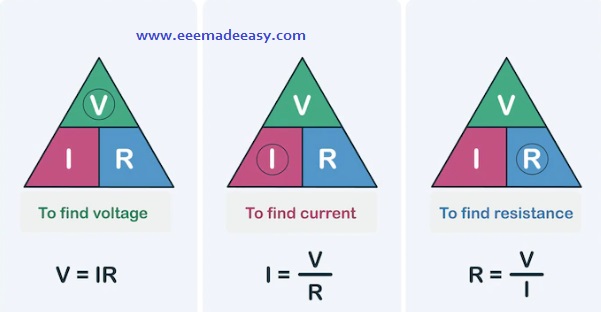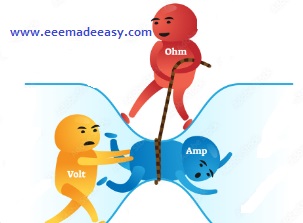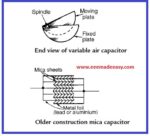What is Resistance?
Resistance is defined as the property of a substance due to which it opposes (or restricts) the flow of electricity (i.e., electrons) through it.
Metals (as a class), acids and salts solutions are good conductors of electricity.
Amongst pure metals, silver, copper and aluminium are very good conductors in the given order.
This is due to the presence of a large number of free or loosely-attached electrons in their atoms.
These vagrant electrons assume a directed motion on the application of an electric potential difference.
These electrons while flowing pass through the molecules or the atoms of the conductor, collide and other atoms and electrons, thereby producing heat.
Those substances which offer relatively greater difficulty or hindrance to the passage of these electrons are said to be relatively poor conductors of electricity like bakelite, mica, glass, rubber, p.v.c. (polyvinyl chloride) and dry wood etc.
Amongst good insulators can be included fibrous substances such as paper and cotton when dry, mineral oils free from acids and water, ceramics like hard porcelain and asbestos and many other plastics besides p.v.c.
It is helpful to remember that electric friction is similar to friction in Mechanics.
- Resistance, Temperature coefficient of resistance
- Conductors, Insulators, Semiconductors
- Basic physical concepts of Electricity : protons,neutrons,electrons
- What is an ion? Ionization
The Unit of Resistance
The practical unit of resistance is ohm.
A conductor is said to have a resistance of one ohm if it permits one ampere current to flow through it when one volt is impressed across its terminals.
For insulators whose resistances are very high, a much bigger unit is used
i.e., mega-ohm = 10^6 ohm (the prefix ‘mega’ or mego meaning a million) or
kilo-ohm = 10^3 ohm (kilo means thousand).
In the case of very small resistances, smaller units like milli-ohm = 10^−3 ohm or micro-
ohm = 10^−6 ohm are used.
The symbol for ohm is Ω.

- Resistance, Temperature coefficient of resistance
- Conductors, Insulators, Semiconductors
- Basic physical concepts of Electricity : protons,neutrons,electrons
Laws of Resistance
The resistance R offered by a conductor depends on the following factors :
(i) It varies directly as its length, l.
(ii) It varies inversely as the cross-section A of the conductor.
(iii) It depends on the nature of the material.
(iv) It also depends on the temperature of the conductor
Neglecting the last factor for the time being, we can say that
R ∝ lA
or R = lA
ρ …(i)
where ρ is a constant depending on the nature of the material of the conductor and is known as its
specific resistance or resistivity.
If in Eq. (i), we put
l = 1 metre and A = 1 metre2, then R = ρ
Hence, specific resistance of a material may be defined as the resistance between the opposite
faces of a metre cube of that material.
Units of Resistivity
From Eq. (i), we have ρ = AR/l
In the S.I. system of units,
ρ = A metre^2 x R ohm/metre
=AR/l ohm-metre
Hence, the unit of resistivity is ohm-metre (Ω-m).
It may, however, be noted that resistivity is sometimes expressed as so many ohm per m^3.
Although, it is incorrect to say so but it means the same thing as ohm-metre.
If l is in centimetres and A in cm^2, then ρ is in ohm-centimetre (Ω-cm).
Values of resistivity and temperature coefficients for various materials are given below.
The resistivities of commercial materials may differ by several per cent due to impurities etc.

Question
A coil consists of 2000 turns of copper wire having cross-sectional area of 0.8 mm2. The mean length per turn is 80 cm and the resistivity of copper is 0.02 μΩ–m. Find the resistance of the coil and power absorbed by the coil when connected across 110 V d.c. supply.
Length of the coil, l = 0.8 × 2000 = 1600 m ;
A = 0.8 mm^2 = 0.8 × 10−6 m2.
R = lA
ρ = 0.02 × 10^−6 × 1600/0.8 × 10^−6 = 40 Ω
Power absorbed = V^2 / R = 110^2/40 = 302.5 W
Effect of Temperature on Resistance
The effect of rise in temperature is :
(i) to increase the resistance of pure metals. The increase is large and fairly regular for normal
ranges of temperature. The temperature/resistance graph is a straight line. As
would be presently clarified, metals have a positive temperature co-efficient of resistance.
(ii) to increase the resistance of alloys, though in their case, the increase is relatively small and
irregular. For some high-resistance alloys like Eureka (60% Cu and 40% Ni) and manganin,
the increase in resistance is (or can be made) negligible over a considerable range of
temperature.
(iii) to decrease the resistance of electrolytes, insulators (such as paper, rubber, glass, mica etc.)
and partial conductors such as carbon. Hence, insulators are said to possess a negative
temperature-coefficient of resistance.
Temperature coefficient of resistance
the temperature coefficient of resistance at a given temperature as the charge in resistance per ohm per degree centigrade change in temperature from the given temperature.
It has been found that although temperature is the most significant factor influencing the resistivity
of metals, other factors like pressure and tension also affect resistivity to some extent.
For most metals except lithium and calcium, increase in pressure leads to decrease in resistivity. However, resistivity increases with increase in tension.
Which is the best conductor of Electricity?
Silver (Ag)
Conductance and Conductivity
Conductance (G) is reciprocal of resistance.
Whereas resistance of a conductor measures the
opposition which it offers to the flow of current, the conductance measures the inducement which it
offers to its flow.
σ is called the conductivity or specific conductance of a conductor. The unit of conductance
is siemens (S). Earlier, this unit was called mho.
the unit of conductivity is siemens/metre (S/m).
Ohm’s Law
This law applies to electric to electric conduction through good conductors and may be stated
as follows :
The ratio of potential difference (V) between any two points on a conductor to the current (I)
flowing between them, is constant, provided the temperature of the conductor does not change.
In other words, V/I = constant or V/I = R.
R : Resistance
Ohms law in detail can be read HERE

- Environment MCQ for RRB JE CBT 2|Objective Questions Environment for Competitive Exams
- RRB JE CBT 2 Computer Awareness Book Arihant|Objective Computer Awareness Book 2025
- RRB JE CBT 2 Exam Date 2025 Postponed|RRB JE CBT 2 Exam Date
- [PDF]RRB JE Result 03/2024 Cut off, Selected no of candidates for all regions
- [PDF]Final Answer Key Junior Instructor Mechanic Agricultural Machinery|643/2023 Solved Question paper
- Acoustics MCQs|Industries Extension officer|IEO 2025
- LASER MCQs| Industries Extension officer|IEO 2025
- Practical Types of Capacitors
- [PDF] Syllabus JUNIOR INSTRUCTOR MECHANIC AGRICULTURAL MACHINERY|643/2023 Syllabus Kerala PSC
- [PDF] Syllabus JUNIOR INSTRUCTOR WOOD WORK TECHNICIAN|674/2023 Syllabus Kerala PSC
- [PDF] Syllabus JUNIOR INSTRUCTOR MECHANIC CONSUMER ELECTRONIC APPLIANCES|670/2023 Syllabus Kerala PSC
- [PDF] Junior Instructor Hospital Housekeeping| 646/2023 syllabus Kerala PSC









